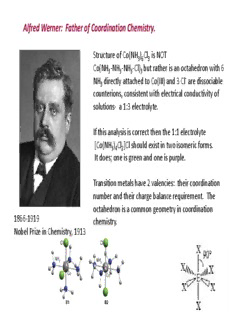
Alfred Werner: Father of Coordination Chemistry. PDF
Preview Alfred Werner: Father of Coordination Chemistry.
Alfred Werner: Father of Coordination Chemistry. Structure of Co(NH ) Cl is NOT 3 6 3 Co(NH -NH -NH -Cl) but rather is an octahedron with 6 3 3 3 3 NH directly attached to Co(III) and 3 Cl- are dissociable 3 counterions, consistent with electrical conductivity of solutions- a 1:3 electrolyte. If this analysis is correct then the 1:1 electrolyte [Co(NH ) Cl ]Cl should exist in two isomeric forms. 3 4 2 It does; one is green and one is purple. Transition metals have 2 valencies: their coordination number and their charge balance requirement. The octahedron is a common geometry in coordination 1866-1919 chemistry. Nobel Prize in Chemistry, 1913 These are real and stable entities. They have thermodynamic stability Foundation Molecules of Transition Metal Organometallic Chemistry • Homoleptic Metal Carbonyls • Ferrocene and Metallocenes • Zeise’s “salt” Metal Carbonyls: German Chemistry, 1930’s “ ” From X-ray crystallography. A portion of a packing diagram or the “ ” extended structure of W(CO) 6 A TEP (Thermal Ellipsoid Plot) of a single molecule of tungsten hexacarbonyl, W(CO) 6 Thermal ellipsoids indicate extent of thermal motion. The tighter, rounder the atom, the better the structure. This one looks great. An octahedron has 48 symmetry operations: E, 8 C , 6C , 6C , I, 6S , 8S , 3σ , 6 σ 3 4 2 4 6 h d W(CO) + PMe W(CO) PMe + CO 6 3 5 3 Ball and Stick structure of W(CO) (PMe ) 5 3 NOTE: PMe is placed along the unique (z) axis. What is the order of that axis? 3 Symmetry operations/elements are lost as compared to W(CO) . What are they? 6 What is the point group assignment? How about multiply substituted complexes: W(CO) (PMe ) => Are there isomers? Point groups? 4 3 2 W(CO) (PMe ) => Isomers? Point Group assignments? 3 3 3 What the metal carbonyls have taught us about TM Organometallic Chemistry: The Eighteen Electron Rule Metal-Metal Bonds Clusters π – backbonding Stabilization of Low Oxidation States ν(CO) IR and Symmetry Ligand Substitution Rxn Mechanisms Charge Distribution Nucleophilic Attack/Reactivity at CO Ligand Conversion of CO to Fischer Carbene Applications to Catalysis (as M(CO) homoleptic complexes) x Water Gas Shift Reaction CO + H O = CO + H 2 2 2 Hydroformylation H C=CH + CO + H => CH CH CHO 2 2 2 3 2 5 Ferrocene: ( -C H ) Fe η 5 5 2 ° ° mpt: 172 C; bpt: 250 C !! No decomposition. https://www.youtube.com/watch?v=H6_E6C_e_fg 5 Ferrocene: ( -C H ) Fe η 5 5 2 Ferrocene: (η5-CH)Fe Orbital overlap 5 5 2
Description: